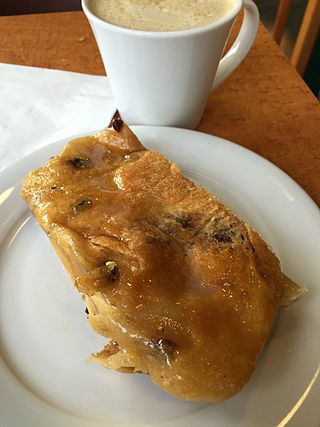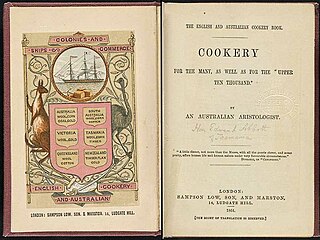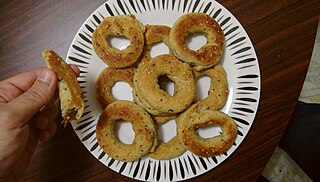 Cherry Madeira cake with whipped cream and tea | |
| Type | Sponge cake |
|---|---|
| Course | Tea or breakfast |
| Place of origin | United Kingdom |
Madeira cake is a sponge or butter cake in traditional British and Irish cookery.
 Cherry Madeira cake with whipped cream and tea | |
| Type | Sponge cake |
|---|---|
| Course | Tea or breakfast |
| Place of origin | United Kingdom |
Madeira cake is a sponge or butter cake in traditional British and Irish cookery.
It is sometimes mistakenly thought to originate from the Madeira Islands but was in fact named after Madeira wine from the islands, popular in England in the mid-1800s and often served with the cake. [1] [2] [3] [4] Madeirans produce their own traditional cake – bolo de mel , dark, spicy and honey flavoured – which is very different. [5] [6]
The cake has a firm yet light texture. It is eaten with tea or (occasionally) for breakfast and is traditionally flavoured with lemon. [7] Nowadays, the English Madeira cake is often served with tea or liqueurs. [8] Dating back to an original recipe in the 18th or 19th century, [1] [8] Madeira cake is similar to a pound cake or yellow cake. [9] [10] One of the earliest published recipes was by Eliza Acton in her Modern Cookery for Private Families (1845): [11]
A Good Madeira Cake: Whisk four fresh eggs until they are as light as possible, then, continuing still to whisk them, throw by slow degrees the following ingredients in the order in which they are written: six ounces of dry pounded and sifted sugar; six of flour, also dried and sifted; four ounces of butter just dissolved, but not heated; the rind of a fresh lemon; and the instant before the cake is moulded beat well in the third of a teaspoonful of carbonate of soda: bake an hour in a moderate oven.

Dessert is a course that concludes a meal. The course consists of sweet foods, such as cake, biscuit, ice cream and possibly a beverage such as dessert wine and liqueur. Some cultures sweeten foods that are more commonly savory to create desserts. In some parts of the world there is no tradition of a dessert course to conclude a meal.

Cake is a flour confection made from flour, sugar, and other ingredients and is usually baked. In their oldest forms, cakes were modifications of bread, but cakes now cover a wide range of preparations that can be simple or elaborate and which share features with desserts such as pastries, meringues, custards, and pies.

An apple pie is a pie in which the principal filling is apples. Apple pie is often served with whipped cream, ice cream, custard or cheddar cheese. It is generally double-crusted, with pastry both above and below the filling; the upper crust may be solid or latticed. The bottom crust may be baked separately ("blind") to prevent it from getting soggy. Deep-dish apple pie often has a top crust only. Tarte Tatin is baked with the crust on top, but served with it on the bottom.

Pound cake is a type of cake traditionally made with a pound of each of four ingredients: flour, butter, eggs, and sugar. Pound cakes are generally baked in either a loaf pan or a Bundt mold. They are sometimes served either dusted with powdered sugar, lightly glazed, or with a coat of icing.

Shortbread or shortie is a traditional Scottish biscuit usually made from one part white sugar, two parts butter, and three to four parts plain wheat flour. Shortbread does not contain any leavening, such as baking powder or baking soda. Shortbread is widely associated with Christmas and Hogmanay festivities in Scotland, and some Scottish brands are exported around the world.

Cheesecake is a dessert made with a soft fresh cheese, eggs, and sugar. It may have a crust or base made from crushed cookies, graham crackers, pastry, or sometimes sponge cake. Cheesecake may be baked or unbaked, and is usually refrigerated.

Ukrainian cuisine is the collection of the various cooking traditions of the people of Ukraine, one of the largest and most populous European countries. It is heavily influenced by the rich dark soil (chornozem) from which its ingredients come, and often involves many components. Traditional Ukrainian dishes often experience a complex heating process – "at first they are fried or boiled, and then stewed or baked. This is the most distinctive feature of Ukrainian cuisine".

A macaron or French macaroon is a sweet meringue-based confection made with egg white, icing sugar, granulated sugar, almond meal, and often food colouring.

A chiffon cake is a very light cake made with vegetable oil, eggs, sugar, flour, baking powder, and flavorings. Being made with vegetable oil, instead of a traditional solid fat such as butter or shortening, it is easier to beat air into the batter.

Lardy cake, also known as lardy bread, lardy Johns, dough cake and fourses cake, is a traditional rich spiced form of bread found in several southern counties of England, each claiming to provide the original recipe. It remains a popular weekend tea cake in the southern counties of England, including Sussex, Surrey, Hampshire, Berkshire, Wiltshire, Dorset and Gloucestershire.

Spekkoek is a type of Indonesian layer cake. It was developed during colonial times in the Dutch East Indies. The firm-textured cake is an Indo (Dutch-Indonesian) version of the European multi-layered spit cake. However it is not baked on a rotating spit, and contains a mix of Indonesian spices, such as cardamom, cinnamon, clove, mace and anise. The cake is made of flour and yolk and is rich in butter or margarine.
A suet pudding is a boiled, steamed or baked pudding made with wheat flour and suet, often with breadcrumb, dried fruits such as raisins, other preserved fruits, and spices. The British term pudding usually refers to a dessert or sweet course, but suet puddings may be savoury.

The English and Australian Cookery Book is considered to be the first Australian cookbook. Published in London in 1864, the full title of the first edition reads: The English and Australian Cookery Book: Cookery for the Many, as well as the Upper Ten Thousand - by an Australian Aristologist. The author, who listed himself only by the initials "E.A." in the introduction, was a Tasmanian named Edward Abbott.

Cabinet pudding, also known as chancellor's pudding or Newcastle pudding, is a traditional English steamed, sweet, moulded pudding made from some combination of bread or sponge cake or similar ingredients in custard, cooked in a mould faced with decorative fruit pieces such as cherries or raisins, served with some form of sweet sauce. Other versions of cabinet pudding might use gelatin and whipped cream.

Ka'ak or kahqa is the common Arabic word for cake or biscuit, in its various senses, and can refer to several different types of baked goods produced throughout the Arab world and the Near East. The bread, in Middle Eastern countries, is similar to a dry and hardened biscuit and mostly ring-shaped. Similar pastry, called "kue kaak", is also popular in Indonesia.

Bread and butter pudding is a traditional bread pudding in British cuisine. Slices of buttered bread scattered with raisins are layered in an oven dish, covered with an egg custard mixture seasoned with nutmeg, vanilla, or other spices, then baked.
Ciambella is an Italian ring-shaped cake with regional varieties in ingredients and preparation. As an example, a basic version of the cake could be prepared using flour, baking powder, salt, eggs, milk, sugar, oil and vanilla flavoring. Honey is sometimes added as a sweetener. To create the light texture the sugar and eggs are whisked together, and oil and milk are added while whisking continuously until the mixture is frothy. Then sifted baking powder and flour are added to the dry ingredients and the cake is baked in a ring shaped pan.

Sponge cake is a light cake made with eggs, flour and sugar, sometimes leavened with baking powder. Some sponge cakes do not contain egg yolks, like angel food cake, but most of them do. Sponge cakes, leavened with beaten eggs, originated during the Renaissance, possibly in Spain. The sponge cake is thought to be one of the first non-yeasted cakes, and the earliest attested sponge cake recipe in English is found in a book by the English poet Gervase Markham, The English Huswife, Containing the Inward and Outward Virtues Which Ought to Be in a Complete Woman (1615). Still, the cake was much more like a cracker: thin and crispy. Sponge cakes became the cake recognised today when bakers started using beaten eggs as a rising agent in the mid-18th century. The Victorian creation of baking powder by English food manufacturer Alfred Bird in 1843 allowed the addition of butter to the traditional sponge recipe, resulting in the creation of the Victoria sponge. Cakes are available in many flavours and have many recipes as well. Sponge cakes have become snack cakes via the Twinkie.